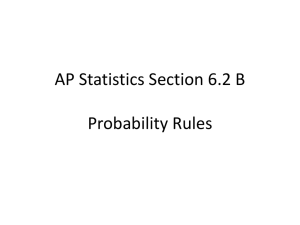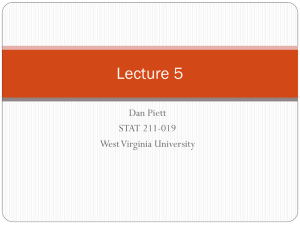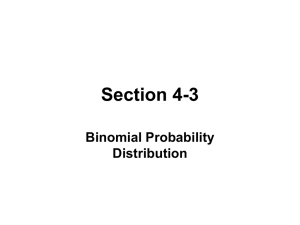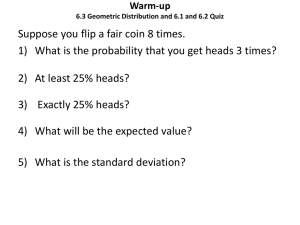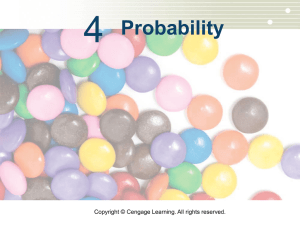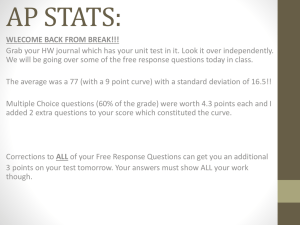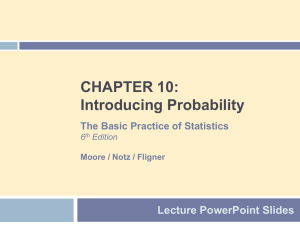question - mathematicalminds.net
advertisement
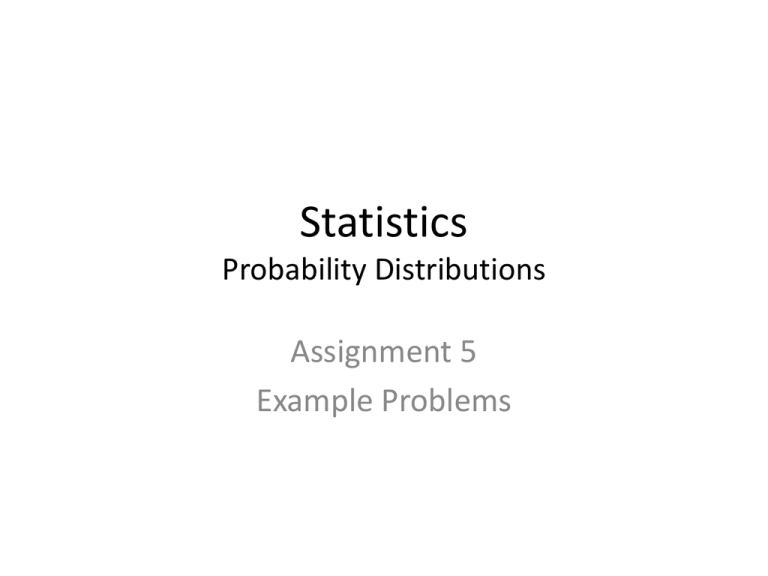
Statistics Probability Distributions Assignment 5 Example Problems Discrete vs. Continuous • Discrete (Countable) – Number of students in this class – Number of points scored in a game • Continuous (Measurable) – Square footage of a house – Time to complete a job Probability Distributions • All probabilities – Must add to 1 – Must be positive – Must be between 0 and 1 • Where 0 is impossible and 1 is certain Mean • Finding the mean of a probability distribution x * P ( x ) 0 * 0 . 0863 x P(x) 0 0.0863 1 0.4935 2 0.2698 3 0.1094 4 0.0319 5 0.0091 1 * 0 . 4935 2 * 0 . 2698 3 * 0 . 1094 4 * 0 . 0319 5 * 0 . 0091 1 . 5344 Standard Deviation • Finding the standard deviation of a probability distribution x 2 x 2 x P(x) 0 0.0863 1 0.4935 2 0.2698 3 0.1094 4 0.0319 5 0.0091 * P ( x ) 0 * 0 . 0863 1 * 0 . 4935 2 * 0 . 2698 3 * 0 . 1094 4 * 0 . 0319 5 * 0 . 0091 3 . 2952 2 2 * P ( x ) 3 . 2952 1 . 5344 2 var iance 2 2 0 . 940817 0 . 940817 0 . 9699 1 . 0 2 2 2 This is the variance This is the standard deviation Probabilities • QUESTION: Multiple-choice questions each have five possible answers (a, b, c, d, e), one of which is correct. Assume that you guess the answers to three such questions. – Use the multiplication rule to find P(WWC), where C denotes a correct answer and W denotes a wrong answer. • ANSWER: Ok, notice there are 5 choices to answer (a,b,c,d,e) so you have a 1 in 5 chance of getting the right answer and 4 in 5 chances of getting the wrong answer. This means – The probability of getting the answer correct = P(C) = 1/5 – The probability of getting the answer wrong = P(W) = 4/5 – So if we get Wrong and Wrong and Correct this would be P(WWC) = (4/5)(4/5)(1/5) = 0.128 NOTE: The word “AND” in probabilities means to multiply Probabilities (continued) • QUESTION: Beginning with WWC, make a complete list of the different possible arrangements of one correct answer and two wrong answers and then find the probability for each entry in the list. • ANSWER: One correct and two wrong would be – WWC, WCW, CWW • P(WWC) = what we got previously= 0.128 • P(WCW) = (4/5)(1/5)(4/5) = see order does not matter with multiplication so = 0.128 • P(CWW) = (1/5)(4/5)(4/5) = see order does not matter with multiplication so = 0.128 Probabilities (continued) • QUESTION: Based on the preceding results, what is the probability of getting exactly one correct answer when three guesses are made? • ANSWER: So this means P(WWC) OR P(WCW) OR P(CWW) 0.128 + 0.128 + 0.128 = 0.384 NOTE: The word “OR” in probabilities means to add Binomial Probabilities • QUESTION: Assume that a procedure yields a binomial distribution with a trial repeated n times. • Use the binomial probability of x successes given the probability p of success on a single trial. • n = 9, x = 6, p = 0.65 • Find P(6) Binomial Probabilities (calculator) • Calculator 1) 2nd Vars 2) Scroll down to binompdf 3) The order is n, p, x so we would enter binompdf(9, .65, 6) <--be sure to close the parentheses 4) press enter to get 0.272 rounded Binomial Probabilities (by hand) • P(6) = 9! ∗ 0.656 9−6 !6! = ∗ 0.353 = 9∗8∗7∗6∗5∗4∗3∗2∗1 ∗ 3 !6! 0.656 ∗ 0.353 9∗8∗7∗6∗5∗4∗3∗2∗1 ∗ 0.656 ∗ 0.353 3∗2∗1∗6∗5∗4∗3∗2∗1 • now I am going to cancel 6*5*4*3*2*1 on top and bottom to be left with 9∗8∗7 ∗ 0.656 ∗ 0.353 3∗2∗1 • cancel the 3 at the bottom with the 9 and cancel the 2 at the bottom with the 8 on top to get 3∗4∗7 ∗ 0.656 ∗ 0.353 1 now i put this in my calculator to get 0.272 rounded WHEW!!! Binomial Probabilities (2nd example) • QUESTION: A brand name has a 70% recognition rate. If the owner of the brand wants to verify that rate by beginning with a small sample of 10 randomly selected consumers, find the probability that exactly 7 of the consumers recognize the brand name. Also find the probability that the number who recognize the brand name is not 7. Binomial Probabilities (2nd example) • ANSWER: What we know • n = 10 (number in sample) • x = 7 (number of successes) • p = 70% or 0.70 • We want to find the probability of exactly 7 P(7) = in your TI83 press • • • • 2nd Vars Scroll down to binompdf The order is n, p, x so we would enter binompdf(10,.7,7) Press enter to get 0.267 (rounded) • Then “not 7” would be the complement of 1 minus the probability of 7 or P(not 7) = 1 – P(7) = 1 – 0.267 = 0.733 Other examples • Other examples posted in same folder

